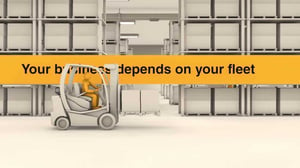 Choosing the right battery size—and the charger to complement it—can certainly be confusing. The reason there's not a straightforward answer is due to the fact that most companies don't have a straightforward material handling operation. Each operation is unique in its own way, which dictates battery and charger needs. That means "size," in many ways, is relative. Most businesses need a motive power partner to help them make decisions that will allow a fleet to function at its optimal level. The ideal partner will perform an assessment to fully analyze your operation and recommend a solution that meets your needs.
Choosing the right battery size—and the charger to complement it—can certainly be confusing. The reason there's not a straightforward answer is due to the fact that most companies don't have a straightforward material handling operation. Each operation is unique in its own way, which dictates battery and charger needs. That means "size," in many ways, is relative. Most businesses need a motive power partner to help them make decisions that will allow a fleet to function at its optimal level. The ideal partner will perform an assessment to fully analyze your operation and recommend a solution that meets your needs.
How to Choose Battery Size
Once you've done a site assessment, it all starts with the battery. There are a variety of factors to consider when choosing the right one. Some of those factors are obvious, while some aren't. It's also important to keep in mind that size relates to the actual physical size, as well as the amount of power your battery needs to operate your forklift effectively. Here's a quick list of what should be considered:
Compartment Size
The importance of compartment size should be obvious: you can't use a gargantuan battery if your forklift truck has a small compartment, no matter how hell-bent you are on turbo-charging your fleet. It simply won't fit.Minimum Weight Requirements
Having the appropriate battery size to offset the weight of a forklift isn't simply for efficiency, but for safety's sake, too. Always check the manufacturer’s specifications for minimum weight. Otherwise, you risk tipping over your forklift under load.Application
Do you lift high loads stories into the air, or are you carrying loads three inches off the ground while covering a lot of territory? There are vast differences in the amount of energy consumed in an hour of work from operation to operation.Maintenance Preference
You need to be willing to provide maintenance on your batteries yourself, or pay a power partner to do it for you. Batteries need to be watered, equalized, and charged properly. There are lower maintenance batteries out there, but those come with a higher price tag.Is your operation able to handle the maintenance of a battery fleet, are you willing to pay for that maintenance, or would your operation be better suited to a lower maintenance battery?
Amp Hour Consumption
When you know how many amp hours you're using in a typical shift, it's easier to determine how dynamic your battery needs to be to meet your needs. The right battery in the right application should be able to last 6-8 hours on a full charge, without having to recharge.How to Choose Charger Size and Type
Charger size can be tied to the type of battery you're using, but there are other operation-specific determinants as well. Here are just a handful to consider:
Number of Shifts/Time Available for Charging
Are you running one shift, or multiple shifts? The answer to this question often dictates the correct charger size, and what battery-charger combo will be most effective.
Charging Style
This is also tied to how many shifts you have. For example, are you hoping to continue charging in the conventional 8/8/8 pattern, or does it make more sense to opportunity or fast-charge? This has a direct impact on how many batteries you'll need per truck: for conventional charging you need three batteries per truck, while with more modern methods you can get away with one.
Amp Hour Consumption
Yes, this matters for the charger, too. Really, it's a domino effect since the ultimate goal is to ensure that the forklift ultimately receives the most efficient charge possible for its application. Matching the right charger with the right battery ensures energy isn't being wasted.
What's the Best Way to Determine the Best Forklift Battery and Charger Size?
The best way is through a full site assessment. Since batteries and chargers can be measured, a good motive power partner can easily determine your typical and peak usage, find any efficiency gaps, and ultimately make an ideal recommendation. Often, by tailoring equipment and technology to your specific application, we can reduce your overall cost of ownership. Instead of just pricing batteries, we can provide a solution that saves your operation significant amounts of money. We do this through increased run-time, energy savings, fewer battery changes, and reducing equipment. That's why you shouldn’t confuse lowest price with lowest cost of ownership. When you have the right technology across the board, it doesn't just create maximum efficiency. It saves you money, too.


